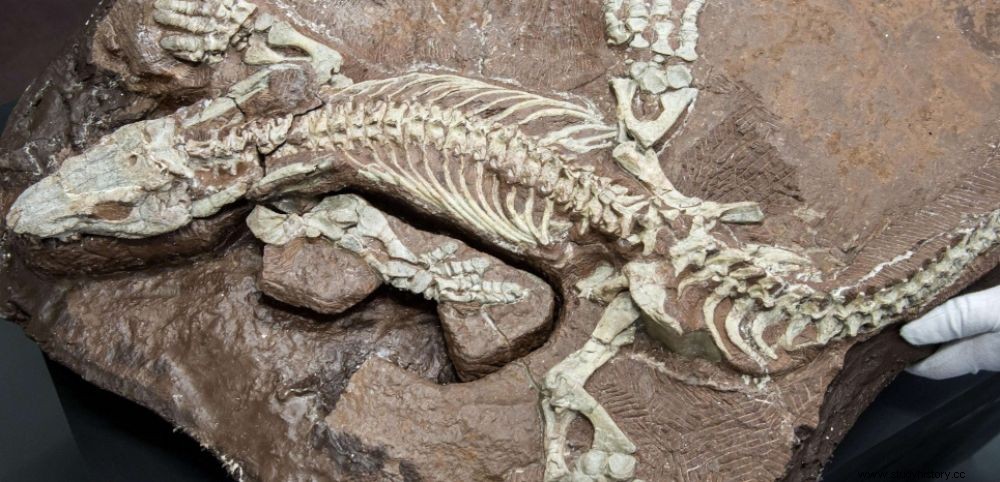They don't just concern dinosaur bones:leaves, footprints, antlers, feathers or scales can fossilize. Explanation of a phenomenon with physical, chemical and geological parameters.

The fossil of an Orobates pabsti, a herbivorous and prehistoric mammalian lizard, on display in April 2016 at the Phyletic Museum in Jena, Germany.
A fossil is a trace, a very old trace, of life. And if we rather think of ammonites or dinosaur bones when we talk about fossils, in reality everything (or almost) can be fossilized, from bones to leaves, including footprints, wood, feathers, scales and shells. Of course, it takes a few conditions, and not the least:lots and lots of time, lots and lots of sediment, and a few other chemical and geological constraints. To understand how fossils are formed, it is necessary to already explain why, most of the time, dead animals do not turn into archaeological sculptures but simply disappear. In general, when an animal passes away, it is immediately devoured by multiple congeners, and there, obviously, no possible fossilization. But sometimes, the corpse does not have time to gluttonize:according to the geological vagaries of the moment, immediately dead and immediately covered with sand, mud or other sediments. Thus buried, it becomes inaccessible to scavengers. The oxygen then breaks down the soft parts. So only the bones or other hard parts remain. Then, little by little, other sediments cover it and bury it.
A fossil is formed provided that...
Then, a number of conditions come to decide the fate of these "leftovers". Condition 1:depth. If the rest of life is not deep enough, it can go up and the bones are then scattered. Result:no fossil. On the other hand, if, by patiently allowing a few million years to pass, the corpse is covered with many layers of sediment, its physico-chemical environment changes:the weight and the pressure increase. Then, passing through, a water table rich in minerals seeps into the pores of the hard parts of the corpse, which then undergo a chemical transformation:the bone changes into stone, a fossil is born. The strange alchemy that allowed this metamorphosis is called fossilization or petrification. He was born the divine fossil, but is far, far underground, inaccessible to archaeologists.
This is where condition 2 comes in:if the fossil continues to sink, covered by successive layers of sediment, the heat and pressure from the depths eventually destroy it. Result:no more fossils. On the other hand, if according to geological movements, the fossil rises, it can then approach the surface and prove to be a miraculous find for the archaeologist in search of traces of past life who precisely waved his tools at this place.
How are leaf or jellyfish fossils formed?
How then to explain the fossils which a priori come neither from bones, nor from shells nor from hard parts likely to be petrified? Concerning the ferns for example, it is not really a question of leaves but of fossil casts:the frond was covered with mud in which it left its mark. Then, under the effect of time, the pressure linked to the burial of various chemical processes, this sludge solidified. Over time, they ended up rising to the surface, in the form of rock. As for the fossils of "soft parts", they are extremely rare. For such a miracle to take place, an additional condition arises:during its descent into the depths, the rest of life must be so well covered that it is even deprived of destructive oxygen. This process allows for brilliant finds from a paleontological point of view since it offers snapshots of extinct animal organs, stomach contents or animals without skeletons such as jellyfish.
Formation of non-rock fossils
Finally, there are other traces of past life that are called fossils even if they have not undergone the petrifications mentioned above. This is the case of mammoths preserved in Siberian permafrost or mosquitoes stuck in amber. They are also treasures for better understanding the evolution of species.
By Marina Lena
